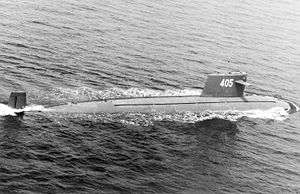Type 091 submarine
 A Type 091 submarine in 1993 | |
| Class overview | |
|---|---|
| Name: | Han-class |
| Builders: | Bohai Shipyard, Huludao |
| Operators: |
|
| Succeeded by: | Type 093 |
| In commission: | 1974-present |
| Completed: | 5 |
| Active: | 3 |
| Retired: | 2 |
| General characteristics | |
| Type: | SSN |
| Displacement: | 5,500 tonnes (submerged) |
| Length: | 98 metres |
| Beam: | 10 metres |
| Draft: | 7.4 metres |
| Propulsion: | 1 Nuclear turbo electric engine - Pressurized water reactor |
| Speed: |
|
| Range: | Unlimited |
| Complement: | 75 |
| Armament: | 6 × 533 mm torpedo tubes |

The Type 091 (Chinese designation: 09-I; NATO reporting name: Han-class) was the first class of nuclear-powered submarines (SSN) deployed by the China's People's Liberation Army Navy Submarine Force
Background
The first chief designer of the submarine was an engineer and scientist of nuclear propulsion engineering, Peng Shilu (
The Han class have primarily operated in local waters. However since the 1990s, Hans have been used more aggressively. A Han shadowed a U.S. carrier battle group in the mid-1990s. In November 2004, a Han made an incursion into Japanese territorial waters and prompted Japan's maritime forces to go on alert for only the second time since the end of World War II. The incursion was through the Ishigaki, Okinawa island group, a lightly populated group of islands very near Taiwan. China later apologized for the incursion saying for "technical reasons", it ventured into Japanese waters.[3]
The Han class have gone through major upgrades and numerous refits since their commissioning. The boats have six 533 mm torpedo tubes and carry 20 torpedoes. Alternatively, they can carry 36 mines in their tubes. The Han class is capable of firing sub-launched variants of the C-801 anti-ship missile as well as a range of indigenous and Russian torpedoes or mines. All remaining hulls have been refitted with new sonars, with Type H/SQ2-262B sonar manufactured by No. 613 Factory replacing the original Type 603 sonar on board. Anechoic tiles were added later to reduce noise levels.
Criticism
The Han-Class is well known for having a noisy reactor and poor radiation shielding, which causes health hazards for her crew as nuclear radiation levels are higher than they should be aboard the submarine. The submarine is also inhibited by an inability to launch missiles while submerged. This creates a tactical disadvantage against opponents that have well-developed anti-submarine warfare systems.[4]
Their design and weapons appear to be inadequate for confronting modern warships. It is believed that long refits have often meant that these submarines have spent more time in port than out at sea, greatly affecting their operational capacity.
Boats of the class
| Pennant Number | Launched | Completed | Status |
| 401 | 1970 | 1974 | Decommissioned 2000 |
| 402 | 1977 | 1980 | Decommissioned 2004 |
| 403 | 1983 | 1984 | Active |
| 404 | 1987 | 1988 | Active |
| 405 | 1990 | 1991 | Active |
Boat 401 has had its nuclear reactor removed and disposed of. The submarine will be fitted out and serve as a museum exhibit.[5]
See also
References
- ↑ Erickson, Andrew S & Goldstein, Lyle J (Winter 2007). China's future nuclear submarine force - Insights from Chinese Writings", Naval War College Review, 60(1): 55-79
- ↑ The Federation of American Scientists & The Natural Resources Defense Council Chinese Nuclear Forces and U.S. Nuclear War Planning p.86
- ↑ "China Apologizes for Submarine Incursion".
- ↑ Type 09-1 Han class, globalsecurity.org
- ↑ "China decommissions 1st nuclear submarine". Xinhua. 2013-10-29. Retrieved 2013-10-29.